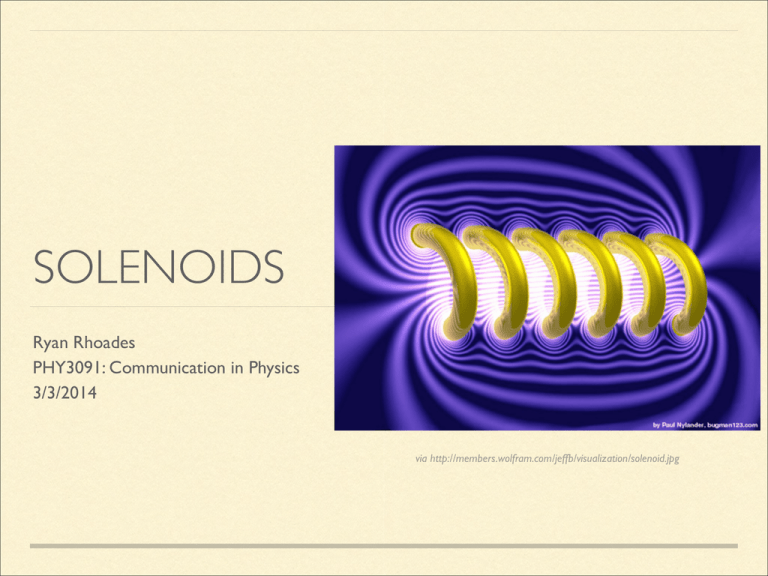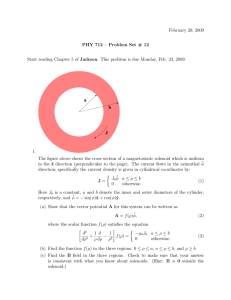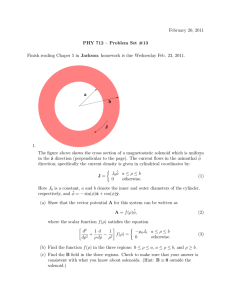
SOLENOIDS
Ryan Rhoades
PHY3091: Communication in Physics
3/3/2014
via http://members.wolfram.com/jeffb/visualization/solenoid.jpg
INTRODUCTION
Basics of electromagnets and solenoids
Electromagnetic principles of the solenoid
Applications and wide-ranging use
ELECTROMAGNET HISTORY
By the 1800’s electrical theory was just
in its infancy
In 1819, Hans Christian Ørsted
discovered that electricity can produce
a magnetic field- magnetic induction
In 1820, André Marie Ampère theorized
the helical solenoidal coil as an effective
way to produce magnetic fields
Lead to the development of the
electromagnet in 1824 by William
Sturgeon
via Wikimedia Commons- http://en.wikipedia.org/
wiki/File:Sturgeon_electromagnet.png
ELECTROMAGNETS AND
SOLENOIDS
Electromagnets depend on this
solenoidal coil to magnetize a
ferromagnetic material.
The solenoid coil: converts the applied electric
current to a harnessable magnetic
field
produces a near-uniform magnetic
field that propagates within the core
in order to create a magnet
via Education.com- http://01.edu-cdn.com/files/static/mcgrawhillimages/9780071382014/f0355-01.jpg
ELECTROMAGNETS AND
SOLENOIDS
Electromagnets depend on this
solenoidal coil to magnetize a
ferromagnetic material.
The solenoid coil: converts the applied electric
current to a harnessable magnetic
field
produces a near-uniform magnetic
field that propagates within the core
in order to create a magnet
via Wikimedia Commons- http://en.wikipedia.org/wiki/
File:Electromagnet_with_gap.svg
A SUMMERY OF THE MAGNETIC
FIELD- WIRE
A force was observed in wires
carrying current (I) through a
magnetic field.
Magnetic force:
!
!
! !
!
FB =qv ⇥ B =IL ⇥ B
The field (B) that resulted in this
force was then derived in the
integrated Biot-Savart law:
! µ0
B =
I
4⇡
I
!
d L ⇥ r̂
r2
via Wikimedia Commons- http://en.wikipedia.org/wiki/
File:Electromagnetism.svg
A SUMMERY OF THE MAGNETIC
FIELD- WIRE
This defined magnetic induction
(B) yields a magnitude azimuthal
to a straight long wire at a
distance (r) away
µ0 I
B=
2⇡r
Now, if one were to take the
circular line integral of the field at
that distance (r) around the wire,
I
! ! µ0 I
B ·dr =
2⇡r = µ0 I
2⇡r
via Wikimedia Commons- http://en.wikipedia.org/wiki/
File:Electromagnetism.svg
AMPERE’S LAW
I
! !
B · d r = µ0 Ie
This relation, Ampère’s circuital law, holds generally, and that if
one can create an encircling loop of a charge carrier, then the
result will always hold.
B-FIELD IN A COILED WIRE
(SOLENOID)
For an ideal, infinitely long
solenoid, we still can apply
Ampère’s law.
Outside of the solenoid, the only
dependence of the B-field is
azimuthal around the solenoid
I
! !
B · d r = B 2⇡⇢ = µ0 I
via HyperPhysics- http://hyperphysics.phy-astr.gsu.edu/hbase/magnetic/
imgmag/sol.gif
µ0 I
)B =
2⇡⇢
B-FIELD IN A COILED WIRE
(SOLENOID)
Inside, if once considers the given
Ampère loop, the component
dependence
is a longitudinal one
I
! !
B · d r = Bz L = µ0 N I
!
via HyperPhysics- http://hyperphysics.phy-astr.gsu.edu/hbase/magnetic/
imgmag/sol.gif
N
) Bz = µ0 I
L
Due to the nature of the
azimuthal B-field of a wire, tightly
spaced coils create a near-uniform
field directed in one direction in
the interior of the solenoid cavity,
independent of radial distance.
IDEAL VS. REAL SOLENOID
Even though the B-field expression of the interior solenoid field
is for an ideal infinite solenoid, this approximation for a finite
solenoid
The azimuthal and non-zero outside longitudinal B-field
components will be much smaller that the near-uniform field
inside
The straight finite solenoid can be seen as an analog to a bar
magnet with comparable magnetic field lines
IDEAL VS. REAL SOLENOID
via HyperPhysics- http://hyperphysics.phy-astr.gsu.edu/hbase/magnetic/
imgmag/barsol.gif
SELF-INDUCTANCE OF A
SOLENOID
Solenoids also have the property of self-inductance and behave as an inductor
Self-inductance (L) occurs when a circuit’s own induced magnetic field
opposes changes in the current, inducing an opposing electromotive force
(emf)
Self-Inductance is defined via the magnetic flux of an inductor, as L=
B
I
Therefore, for a solenoid of N-turns the self-inductance will be approximately
L=
B
I
=
N
N
µ0 I L A
I
N2 2
= µ0
⇡r
L
TAILORING A SOLENOID
One can change the electrical and shape parameters of the
solenoid, but one can also change the solenoid cavity
For electromagnets, a ferromagnetic core is placed in the
solenoid to direct the magnetic field. This changes the field in the
solenoid via a new effective permeability constant
N
B = µ0 I
L
N
) B = µe↵ µ0 I
L
where 1 µe↵
0
SOLENOID APPLICATIONS
The Compact Muon Solenoid @ CERN
Magnetic Resonance Imaging (MRI)
Cars
Toroids
COMPACT MUON SOLENOID
The CMS is a particle detector
experiment at the CERN Large Hadron
Collider.
The experiment’s solenoid is comprised of
superconducting coils cooled to -268.5℃
able to generate B-fields of near 4 T (with
inductance values of 14H and operating
currents of 19,500A) with a diameter of
15m.
via CERN- http://cms.web.cern.ch/sites/cms.web.cern.ch/files/styles/
large/public/field/image/0611042_01-A4-at-140001.jpg?
itok=jNpvZNf_
The magnet is used to bend the paths of
charged particles traveling through a Bfield, allowing them to be traced and
detected.
COMPACT MUON SOLENOID
MAGNETIC RESONANCE
IMAGING
MRI’s essentially use a oscillating
resonant magnetic field in order to
align the magnetic moments of
water in the body, and excite the
hydrogen in the water and detect
body tissue based on the relation of
the excited particles
The solenoid magnets in MRI’s range
from 1.5-3T, and now generally
made from superconducting coils
via Wikimedia Commons- http://en.wikipedia.org/wiki/
File:Mri_scanner_schematic_labelled.svg
Requires magnetic gradients
MAGNETIC RESONANCE
IMAGING
CAR STARTER MOTORS
A solenoid is present in the starter
motors of modern automobile
When the ignition switch is turned on,
a small current passes through the
solenoid. The magnetic field it
generates causes the large current
contacts for the car battery to close,
starting the starter motor
via Wikimedia Commons- http://en.wikipedia.org/wiki/
File:Automobile_starter.JPG
When the engine starts, the solenoid
becomes de-energized, and the
starting motor contacts are
disconnected from the starting battery
TOROIDS
A toroid is a solenoid that has its ends
fixed to itself
Has the property of having a
completely confined magnetic field
within its interior
N
B = µ0 I
2⇡r
µ0 N 2 r 2
L=
2R
via HyperPhysics- http://hyperphysics.phy-astr.gsu.edu/hbase/magnetic/
toroid.html
This results in higher inductance for
electrical components and low
electromagnetic interference to circuits
CONCLUSION
Solenoids are fundamental to electromagnetics
Due to their symmetry, they produce near-uniform magnetic
fields independent of cross sectional area with little external
fields
Have wide-ranging applications due to their tunable parameters
and properties in generating B-fields
REFERENCES
CERN, "What is CMS?" 2014 (Feb 28), (2014).
HyperPhysics, "http://hyperphysics.phy-astr.gsu.edu/hbase/magnetic/solenoid.html," 2014 (Feb, 2014), .
John D. Kraus, Electromagnetics, 4th ed. (McGraw-Hill, New York, 1992), .
Pual Lorrain and Dale R. Coroson, Electromagnetism: Principles and Applications, 2nd ed. (W.H.
Freeman and Company, San Francisco, 1978), .
Wikipedia, "http://en.wikipedia.org/wiki/Physics_of_magnetic_resonance_imaging," 2014 (Feb, 28),
(2014).
Wikipedia, "http://en.wikipedia.org/wiki/Starter_solenoid," 2014 (Feb, 28), (2014).
Richard Wolfson, Essential University Physics, 1st ed. (Pearson Addison-Wesley, San Francisco, 2007)
Vol. 2.






